Recent Posts
Preparing Your Home for Water Damage in the Spring
4/21/2023 (Permalink)
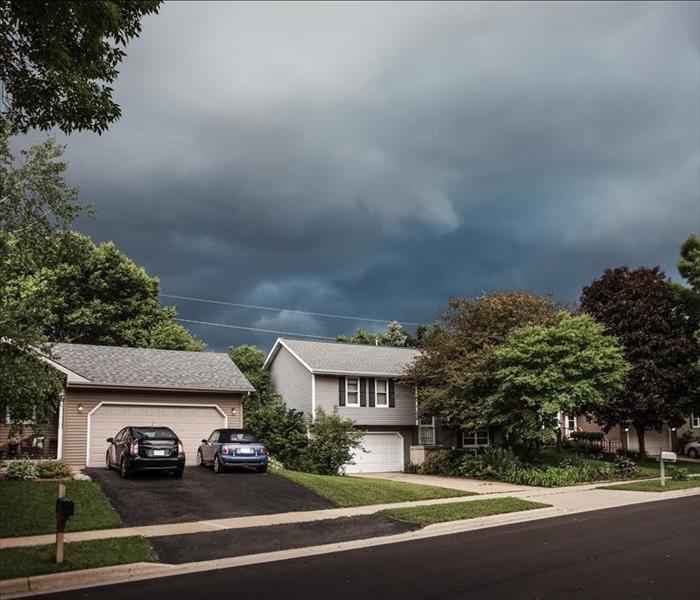 It is essential that you prepare accordingly to prevent catastrophic and costly water damage.
It is essential that you prepare accordingly to prevent catastrophic and costly water damage.
April showers bring… water damage! Heavy rain and thunderstorms during the spring months can compromise the safety of your home. The excess rain and moisture in the air makes your home ripe for water damage. It is essential that you prepare accordingly to prevent catastrophic and costly water damage.
Follow these guidelines to effectively prepare your home:
- Inspect your property. Start with a broad inspection of your home and surrounding property. Carefully look at your roof, gutters, window wells, pipes, walls, foundation, etc. Make a list of items that need further inspection by a professional. In particular, look for the following signs of vulnerability in, on, and around your home:
- Damaged or missing shingles on your roof. Weakened or impaired roof singles provide a space for water to leak into your home.
- Clogged drains and gutters. These areas should be cleared of debris.
- Water stains or soft spots on walls or ceilings. Look for discolored, peeling, or bubbling paint. Other signs of water damage include brown spots and rings both inside and outside of your home.
- Inadequate sealing around windows, doors, and the respective frames. Sealant should be tight enough to prevent moisture from entering your home. Also, note any cracks or spaces around these vulnerable areas.
- Unsealed caulk throughout your home.
- Finally, inspect your property for any odd smells. Water damage and mold can emit a musty or damp smell.
- Know early warning signs of potential flooding. Do your roof and gutters land right beside the foundation of your home? Consider moving the gutter runoff to another location. If the runoff lands near the foundation of your home, you face a higher risk of flooding.
- Check your flood prevention systems. What good are faulty prevention systems??? Check things like sump pumps and other waterproofing systems to ensure they are in working order prior to the spring rainy season.
- Clean gutter and downspouts at least twice per year. This will keep water flowing off and away from your house.
- Treat your pipes well. Avoid pouring grease and other oil or fats down the drain.
- Know about your home’s shut off valves. Most importantly, identify the location of your home’s shut off valve and know how to turn off the water.
- Avoid making repairs on your own. It is not recommended that you DIY at home repairs to the foundation of your house. Bring in a specialist to handle the fundamental components of your home.
- Read through your home insurance policy.
- Have a plan in place for how you will address water damage to your home. No matter how diligent you are with prevention, sometimes water damage is inevitable. The first step to water damage restoration is assessment of the situation. The following factors impact how water damage restoration should be handled.
- Stop and assess the situation. The circumstances will vary greatly from homeowner to homeowner. Carefully look at your home and property.
- How much water is in or around your home? A minor amount of water damage may be handled independently. However, minor situations can rapidly escalate in severity if there is mold or other problems. Larger water damage restoration projects should be handled by an expert.
- Find the source of the water damage. Some varieties of water damage will be unsafe to clean on your own. For example, black water comes from sewers or other bodies of water and may contain very harmful bacteria. Always have a specialist handle black water damage restoration.
Springtime showers do not need to cause damage to your home. Be proactive in safeguarding your property. When in doubt, seek out a specialist. At SERVPRO of Wellington South we are here for all of your water damage needs. Call us today!
What To Do After Major Storm Damage
10/21/2022 (Permalink)
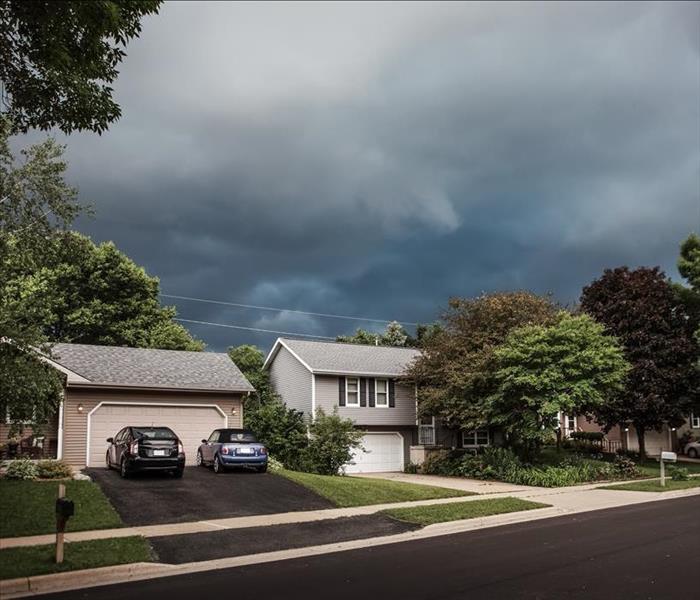 Follow these basic steps when your home has been damaged by a storm.
Follow these basic steps when your home has been damaged by a storm.
The power of nature can be devastating when it takes the form of storms and natural disasters. At best, storms are messy and inconvenient. At worst, storms can damage or destroy property and place humans and animals in potentially deadly situations. After a storm passes through your town, it can be shocking and difficult to know what to do.
If you’re facing major storm damage in Wellington, you’re probably wondering about what your next move should be. Rest assured, many homeowners find themselves overwhelmed and confused when storm damage their homes.
For this reason, we will cover a few basic steps to follow when your home has been damaged by a recent storm.
Move to Safety
If your home sustained major storm damage in Wellington, the most important step to take is moving yourself, your family, and your pets to safety. Severe storm damage can make a home uninhabitable. If a home has severe storm damage, staying in it could increase the risk of becoming stick or injured. To avoid this, it is important to find a safe, dry place to take shelter. You might choose to room with family or friends nearby or secure long-term arrangements at a local hotel.
In some cases, homeowner’s insurance policies will cover the cost of obtaining shelter while your home is being repaired.
Make a Record of the Damage
When the storm has passed and it’s relatively safe to approach your home, perform a walkthrough and take photos of the damage. You might also want to record video evidence to showcase the extent of the destruction that occurred.
It is most important to stay safe when walking through your home after a storm. However, record as much evidence as you can without putting yourself in harm’s way. This way, you’ll have compelling information to show your insurance adjuster later.
If possible, search through your photo albums or online storage to see if you have photos of your home before the storm. This way, you’ll be able to make an accurate comparison between the two conditions.
Additionally, it’s a good idea to create a list of the items in your home that were either lost or destroyed during the storm. If your homeowner’s insurance policy covers damaged furniture and personal possessions, providing a list of what you’ve lost will be helpful. If you can find prices and receipts for the items lost, there’s a better chance that they’ll be covered.
Contact Your Insurance Company
After documenting the damage done to your home, contact your insurance company and file a claim. A homeowner’s insurance policy will usually cover the cost of repairing damages brought on by storms.
Remain available and in contact with your agent or representative. They will guide you through filing a claim and the next steps to taking care of the storm damage. The process involved in getting storm damage repairs taken care of can be tedious so be sure to cover all of your bases when preparing to have repairs done.
Prevent Further Storm Damage
If possible, take steps to prevent further damage from affecting your property. For example, cover broken windows with plastic sheets, or place a tarp over a leaking roof. You might be able to block off flood waters as well. However, if the house experienced significant flooding, pumping out flood water might be easier said than done.
Do what you can to protect your home, but avoid putting yourself in harm’s way while doing so.
Keep Track of Storm Damage Repair Documents
As mentioned above, having storm damage repairs or storm damage restorations done can be a hassle. A good deal of paperwork is usually involved, and you will likely need to speak with several insurance representatives, adjustors, contractors, mortgage professionals, and more.
Keep track of the names, businesses, contact information, and paperwork associated with each individual involved in your home repair.
Avoid accepting any sort of verbal agreement and request everything in writing. Keep all of your documents in a safe area where you can easily access the records you need later.
Work with Storm Damage Specialists
In some cases, your insurance company might recommend a reputable contractor to perform necessary repairs or oversee a restoration project. In other cases, the insurance company will have you search for and choose repair professionals to restore your home.
Either way, research the options available for repairing storm damage in Wellington. To make the best choice in contractors, look for companies that
- operate locally
- have experience repairing storm-damaged homes
- can provide at least three references
- know how to work with insurance claims
- have been in business for years
- can present proof of licensure and insurance coverage
- have a positive reputation and good (or great) third-party reviews
To be sure you’re getting an accurate impression of a contractor’s reputation and quality, check for reviews on independent websites like Yelp, Google Business Reviews, Angi, Consumer Affairs, the Better Business Bureau, HomeAdvisor, or FourSquare.
During the time spent researching your options, you might come into contact with contractors who don’t exhibit good customer service. If a contractor or their representative hesitates to answer your questions, won’t provide their license number (or their business address), offers you an incredibly cheap quote, or seems rude and dismissive, move on. The last person you want repairing your home is someone who might not even be qualified to perform the work.
Find a contractor that is personable, responsive, informed, and established.
Anyone whose home has sustained major storm damage knows how frustrating it can be to initiate storm damage repairs. The situation is never ideal and the stress and sadness you’re dealing with on top of the damage done to your home can be overwhelming.
However, if you proceed carefully and keep track of each step of your response plan, you’ll get through this struggle. Take a moment to appreciate that your family is safe and remind yourself that your home is going to be repaired. After all the irritation and hassle involved in storm damage restoration, you’ll be able to return to a safe, damage-free home.
As always, SERVPRO of Wellington South is here for all of your storm damage repair needs. Call us 561-800-3450.
Water Damage Restoration Tips: Prevention and Restoration
10/13/2022 (Permalink)
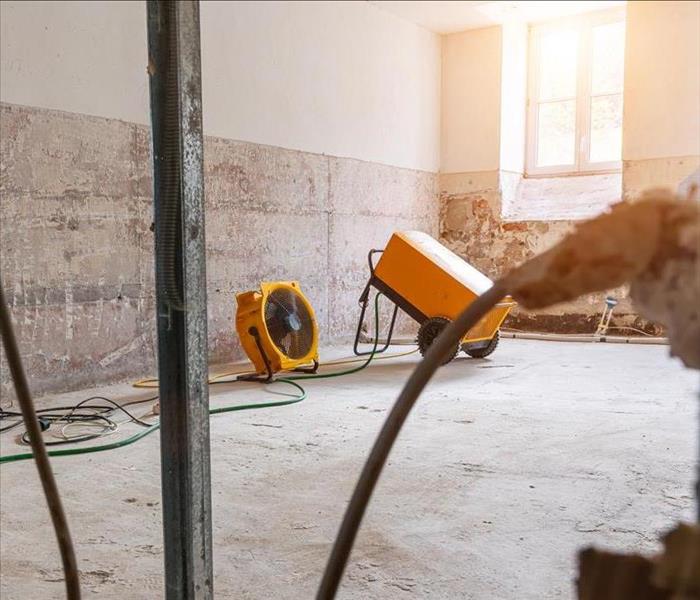 SERVPRO of Wellington South is your go-to water damage restoration company.
SERVPRO of Wellington South is your go-to water damage restoration company.
Every state in the United States has experienced some type of flooding within the past six years. And with flooding, comes water damage. Even if you do not live near a body of water, you may still be at risk for facing water damage. Water damage can be hazardous and costly.
Natural causes of water damage include: thunderstorms, hurricanes, heavy rain, even snow melting hundreds of miles away, which makes the flood waters rise. Broken pipes, damaged appliances, sprinkler system issues, sewer line backups, and overflowing tubs and sinks can also lead to water damage. And water damage or the threat of water damages is not to be taken lightly. When water damage occurs, time is of the essence.
Water Damage Prevention Tips
The best thing you can do is have a prevention plan in place for water damage. When water damage occurs, a homeowner must act fast. Prepare yourself now and avoid major damage later.
- Know the sources of water both inside and outside of your building.
- Sources of Interior Water: plumbing, piping, drains, fire sprinklers (piping and sprinkler heads), shower, bath, laundry, condensation sources, pool/spa plumbing and pumps, mechanical systems (evaporators and piping), etc.
- Sources of Exterior Water: neighboring properties, city water supply, exterior plumbing, foundations, groundwater, irrigation systems, roofs and roof drains, septic systems, windows and doors, siding, waterproofing, etc.
- Ensure good water runoff. Clean your gutters and inspect downspouts to ensure they are pointed in the correct direction and working properly.
- Know the location of the stopcock. Ensure family members know where and how to shut off the water supply. Severe damage can occur within minutes of a leak so it is essential to act quickly.
- Periodically and proactively check for leaks. Check under sinks and around appliances such as dishwashers and washing machines. Even minor leaks can cause major water damage if left unattended. For example, a leaky tap can leak up to 57 gallons of water per week.
- Keep gutters clear of debris. Ensure gutters are not blocked or sagging. If either is occurring, clean and repair gutters promptly.
- Inspect your roof on the inside and outside. Check attic for leaking water. Look for discoloration on ceiling. Check the roof exterior for visible damage.
- Pipes, pipes, pipes… If a property will be unoccupied for an extended period of time, turn off the water supply at the stopcock. You may wish to consider draining the system so no water is left in the pipes. In colder climates, use a smart thermostat to maintain a minimum temperature in your home to prevent pipes from freezing. Properly insulate exposed pipes.
- Use a water leak detection device. These devices turn off the water supply should you have a leak. This is especially useful if your property will be vacant for an extended period of time.
- Check for moisture and mold. Flaky paint or wallpaper is a sign of dampness. Be on alert for musty smells and cold walls. This may indicate the need for additional insulation. Look for window and skylight condensation in the mornings. This may mean elevated levels of moisture.
Water Damage Restoration Tips
When water damage occurs, it is imperative that you act quickly. Use the following water damage restoration tips as soon as you notice signs of water damage.
- Immediately disconnect outlets. Upon noticing water damage, unplug all electronics immediately. Even if you do not yet see the severity of damage, be cautious around appliances and gas lines. Failure to unplug electronics could lead to electrical shocks and explosions.
- Eliminate all water and moisture. Use dehumidifiers and water pumps to remove moisture from the air and water from the ground. Stimulate air circulation in the room through the use of air movers, portable ventilators, and open windows. Try to make the room breezy and dry.
- Look for mold. After you have removed the water and moisture, notice the smell. If indoor air smells musty, you may have a mold or mildew problem. Sometimes, household cleaning products will remove the mold. However, mold can spread quickly, often requiring a mold specialist. Do not attempt to fix major mold problems on your own. Mold can lead to serious health problems.
- Remove the damaged materials. Immediately dispose of porous water-soaked materials, such as insulation or carpet, to avoid mildew. Focus on the ceiling and the floors first. Unsealed structural materials, such as unsealed cement, drywall, and wood, should be replaced to support water damage restoration efforts. Water can make the structure of your building unsafe, so it is essential to focus on replacing structural materials first.
- Disinfect all of the remaining areas. Water can contain bacteria and other hazards that are damaging to your health. Once your remove the water and damaged materials, disinfect the entire area before beginning the water damage restoration process. Bacteria can be invisible. Use bleach to wipe surfaces so the mold spores do not continue to grow. The goal is to eliminate any possible bacteria present.
Water Damage Repair with SERVPRO of Wellington South
The water damage restoration process can be tiresome and stressful. Take one step at a time and act quickly. Use safety precautions to avoid harming yourself and your loved ones. Remember, it is possible to return your property to its previous condition. Enlist the help of professionals when needed.
SERVPRO of Wellington South is your go-to water damage restoration company. Please contact us today to assess your water damage and make it “Like it never even happened.”
Mold Remediation: The Inside Scoop
10/6/2022 (Permalink)
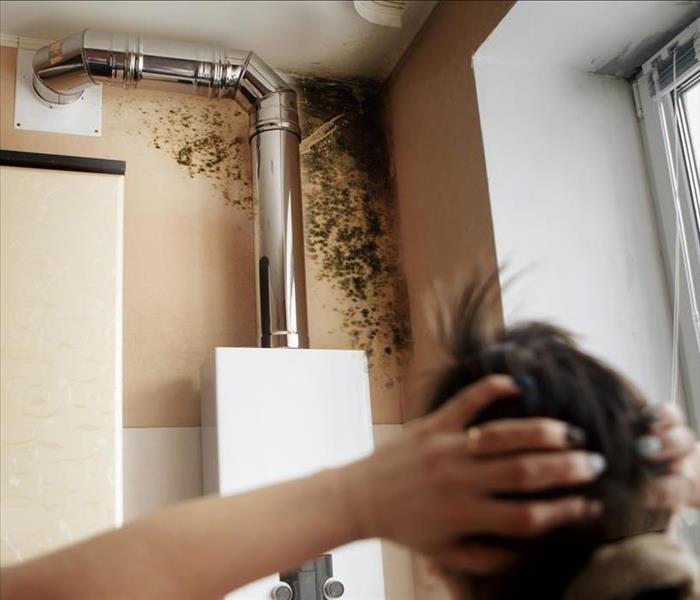 SERVPRO of Wellington South can help you prevent further mold damage through expert mold remediation services.
SERVPRO of Wellington South can help you prevent further mold damage through expert mold remediation services.
Mold damage to your property is never pleasant. The thought of mold alone makes some people cringe, mainly when the mold exists inside your home or business. While it is essential to try and prevent mold growth in the first place, mistakes happen, and it’s not uncommon for people to make minor oversights that lead to worse mold problems.
One way to address mold issues on your property is through mold remediation. Mold remediation goes a step further than removal by targeting the source of the mold damage and combatting the infestation to prevent further damage.
Mold remediation is one of the best decisions you can make to maintain the integrity of your property and keep your environment safe from mold caused by excess moisture and humidity. This article will cover the steps of the mold remediation process, why mold remediation is essential to anyone dealing with mold damage, and how you can avoid mold growth in the first place.
The Mold Remediation Process, Explained
Mold remediation removes mold from a property by identifying its source and removing all traces of the harmful mold. Remediation cleans and disinfects contaminated areas to help prevent mold growth from happening in the future.
Mold remediation is typically a seven-step process that gets to the root of why you are experiencing mold infestations. Whereas mold removal eliminates the visible mold, it does not target the source of the problem.
Choosing mold remediation is essential to fight against mold growth. Below are the seven steps of the remediation process to prevent mold damage to your property.
- Call an emergency contact service once you notice the mold. For example, services like SERVPRO of Wellington South are crucial points of contact for beginning the cleanup and restoration process. Contacting SERVPRO of Wellington South ensures that experts will solve your mold problem with the right resources to get to the root cause of the mold.
- Once you’ve contacted emergency services, the inspection and mold damage assessment process begins. During this step, experts will inspect your property and identify any signs of mold. An expert is crucial for this step, as mold often stays hidden from plain sight and is challenging to detect.
- After the assessment, experts will begin mold remediation procedures, starting with containment. Containment procedures are crucial for preventing any further spread of mold infestation. Removal teams will use various procedures to contain the infestation, such as negative air chambers that isolate the mold damage.
- Once containment is complete, specialists will begin the air filtration process. This step allows for the collection of mold spores out of the air to prevent the spread of mold. Air filtration is crucial to keep mold spores away from you and from spreading to other areas of your property.
- Following air filtration, mold remediation teams will begin removing the mold and any mold-infested materials. Remediation strategies depend on your property's mold damage and what surfaces are housing the mold. The removal process will involve antifungal and antimicrobial treatments to target mold colonies and minimize the chance of new colonies appearing. This step might get complex depending on the extent of the mold damage. Remediation teams may remove any porous materials like drywall for a successful remediation.
- The penultimate step of the mold remediation process is cleaning your belongings to remove any lingering impact of mold damage or unpleasant odors. Remediation teams must clean things like decorations, furniture, or clothes to keep mold away from your property.
- The final step to successful mold remediation is restoration. Restoration depends on the mold damage level and any materials removed during the remediation process. Restoration might include minor repairs like replacing your drywall or insulation but could also entail more significant repairs and reconstructions to your property.
Why Mold Remediation is Important
Mold remediation might seem lengthy and expensive compared to simple mold removal. Because of this, many people don’t understand the importance of mold remediation to keeping your property safe. Though mold remediation is an investment on your behalf, leaving the issue unaddressed or removing the visible mold will likely incur more significant expenses in the future.
Mold remediation reduces the chance of future problems occurring because of mold damage. If you choose mold removal over remediation, you will likely face a repeated cost, as the mold will return to your property and require removal. You can only solve mold outbreaks with remediation to prevent further damage to your property and health.
How Can I Prevent Mold in the First Place?
Mold remediation is essential to address your current mold problems and prevent further mold damage and outbreaks. While remediation is a must if you notice mold on your property, there are ways to prevent mold from growing that will save you time and stress. The CDC recommends five preventative measures to keep mold outside of your property.
- Make certain humidity levels are low on your property. Mold forms because of excessive moisture and humidity levels, and humidity above 50% can spell trouble for your property. If you are unsure how to keep mold damage from harming your property, you should consider investing in a dehumidifier or quality air conditioning unit. You should check humidity levels multiple times daily, especially during warmer seasons.
- Get rid of any leaks in your home. If you’ve ever noticed that sometimes water drips in from cracks, you should take care of this as soon as possible. Any leaks on your property will provide mold with a place to grow.
- Use fans and vents on your property. Airflow is crucial to preventing mold damage and the need for mold remediation. Exhaust fans and vents are essential to keeping a healthy airflow and preventing excess moisture.
- Keep your bathroom clean. Bathrooms are a breeding ground for mold because they are most likely to suffer damage from excess moisture and humidity. Cleaning your bathroom walls with mold-killing products is vital to keeping mold outside your property.
- Remove and replace items like upholstery and carpeting that are soaked with moisture and cannot be dried immediately. To prevent the need for replacement, consider eliminating carpeting from places like your bathroom or basement.
Mold Remediation Experts
Mold remediation is essential for preventing possible damage to your property caused by excessive humidity and moisture. Some ways to prevent mold from growing on your property will save you time, stress, and money.
However, if you notice or suspect mold damage, you must call an expert service immediately. SERVPRO of Wellington South can help you prevent further mold damage through expert remediation services. Contact us today to speak with a mold damage specialist.
How to Handle Fire Damage in Your Home or Business
10/4/2022 (Permalink)
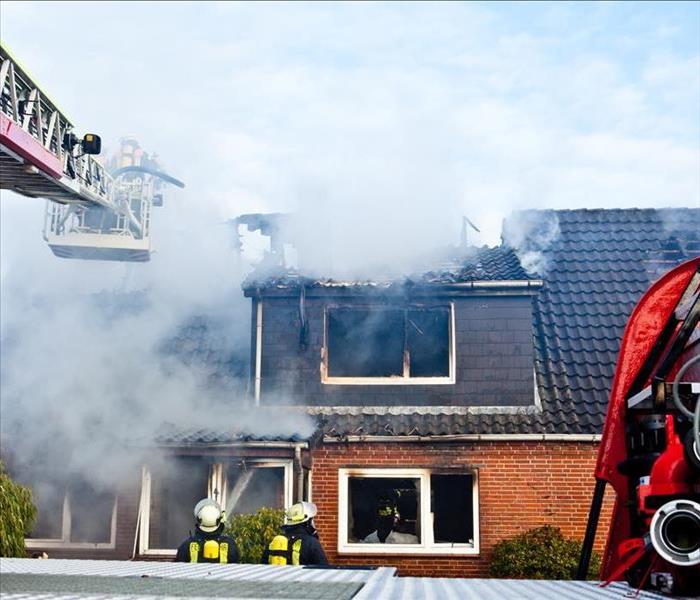 SERVPRO of Wellington South is here for you for all of your fire damage restoration needs. Our team of fire damage specialists is on call and ready to
SERVPRO of Wellington South is here for you for all of your fire damage restoration needs. Our team of fire damage specialists is on call and ready to
When a tragedy like a home or business fire occurs, it is natural to feel shock. Your emotional recovery is just as important as the fire damage restoration. While this article focuses on repairing structures, there are many ways to receive emotional support including your local Red Cross. Disaster stress should be treated by a professional who has special expertise in the area. It is important to know where to begin and who can help.
Fire damage repair and restoration services are available for your home or business. The following checklist will provide the steps necessary to initiate a safe and efficient fire damage restoration.
Before Entering
Immediately following a fire, listen carefully to first responders. Seek medical help as needed. Do not reenter your home or business until a member of the fire department deems it safe to enter. Check for loose power lines, structural damage, broken gas lines, and other damage. Do not allow children to enter until you have conducted an initial inspection following the fire. The site may be unsafe. Moreover, observing the damage could cause emotional harm to young children.
What to Expect After a Fire
Depending upon the severity of the fire, damage to your home or business may be serious. Flames, heat, smoke, and water can all cause fire damage. Firefighters may have needed to break windows or even cut holes in the roof to put out the fire. Your personal items will most likely be wet from water used to extinguish the fire.
Upon Entering
Once you have examined the outside for damage and deemed it safe to enter, proceed vigilantly. Depending on the situation, safety gear like boots, hard hat, goggles, and other safety equipment may be required. Trust your senses. Use caution before touching fire damaged items; the soot and remaining water could be dangerous.
Detecting Gas After a Fire
Smell for gas and listen for a hissing noise, which indicates a gas leak. If you notice any signs of gas, immediately exit the property. If possible, open windows and doors for more ventilation.
Electrical Issues Following a Fire
If you see sparks, frayed wires, smell burning rubber or the like, immediately turn off electricity from the circuit breaker or main fuse box. If there is water between you and the fuse box, call a professional electrician. Disconnect and check all appliances.
Begin Documenting the Fire Damage
Take photographs and videos of the damage. You want documentation of where the fire damage occurred in order to substantiate insurance claims. Begin compiling a list of lost and damaged items. Includes receipts when possible.
Contact Insurance Agent
Contact your insurance agent as soon as possible. Your agent will advise you what to do first. Report how, when, and where the damage occurred. Ask what you should do to keep your home safe until it is repaired. Ask who you should talk to about cleaning your home or business.
In addition, ask your insurance company about how to learn the value of your home and property. If you do not have insurance, the following organizations may be of service:
- American Red Cross
- Federal Emergency Management Agency (FEMA)
- US Department of Housing and Urban Development (HUD)
- Salvation Army
- Fire departments
- Religious organizations
Cleaning Up After a Fire
Find out if you or your insurance company will pay for cleaning the fire damage. SERVPRO of Wellington South specializes in cleaning and fire damage restoration and has 24-hour emergency service. While each situation is unique, the fire damage restoration process may look something like this:
- Emergency Contact
- Inspection and Fire Damage Assessment
- Immediate Board-Up and Roof Tarp Service (if needed)
- Water Removal and Drying (if water damage is present)
- Removal of Smoke and Soot from All Surfaces
- Cleaning and Repair
- Restoration
Replace Documents and Records
Asses fire damage to important documents. You will want to quickly replace any of the following documents:
- Driver’s license (Department of Motor Vehicles)
- Government Issued ID (Contact the issuing authority)
- Social security/Medicare cards (Local Social Security office, 1-800-772-1213 or TDD/TTY 1-800-325-0778)
- Auto registration (Local DMV, Department of Revenue, or any motor vehicle agency)
- Titles and deeds (Records department of the area in which the property is located)
- Insurance policies (Your insurance agent or company)
- Credit cards (Contact issuing companies as soon as possible)
- Stocks and bonds (Issuing company or your broker)
- Wills (Your attorney)
- Medical records (Your doctor, hospital, and other medical facilities where you received treatment)
- Warranties (Request a certified copy of the recorded document from the County recorder)
- Income tax records (IRS center where filed, your accountant, or 1-800-829-1040)
- Citizenship papers (Bureau of Citizenship and Immigration Services, 1-800-375-5283)
- Passports (State Department – Passport Services, 202-955-0430 (24 hours))
- Birth, death, and marriage certificates (Bureau of Records in the appropriate state)
- Mortgage papers (Lending institution)
- Divorce papers (Request copy from state or local vital records department where you divorced)
- Military discharge papers (Department of Veterans Affairs, 1-800-827-1000 or TDD/TTY 1-800-829-4833)
Next Steps After a Fire
As you continue to recover from the fire damage to your home or business, keep a folder for documents and records. Begin saving receipts for money spent in the fire damage restoration process. Contact your accountment or the IRS to determine if you are entitled to any benefits for people recovering from fire damage. Update your Family Disaster Plan and replenish emergency supplies. Ask for help.
As always, SERVPRO of Wellington South is here for you for all of your fire damage restoration needs. Our team of fire damage specialists is on call and ready to help!

 24/7 Emergency Service
24/7 Emergency Service




